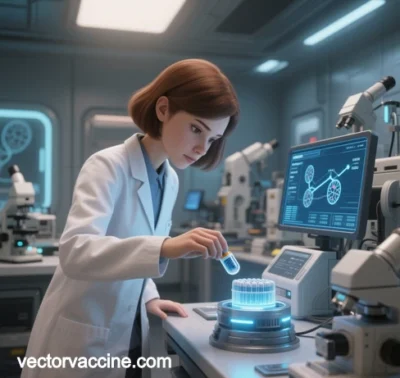
Vector Vaccines: Advantages and Challenges Compared to Traditional Vaccines
I. Innovative Technical Principles
Vector vaccines use genetic engineering to insert pathogen antigen genes into harmless viral (e.g., adenovirus, poxvirus, VSV) or bacterial vectors. These vectors deliver antigens to host cells via their infection mechanisms, inducing immune responses. Unlike traditional vaccines (e.g., inactivated, live-attenuated, protein subunit), their core innovation lies in “gene delivery” and “intracellular antigen production”, bypassing the limitations of relying on pathogen cultivation or recombinant protein synthesis.
II. Core Advantages of Vector Vaccines
- Immune Response Strength and Breadth
- Dual Immune Activation: Vector vaccines simultaneously activate humoral immunity (antibodies) and cellular immunity (T cells), offering enhanced targeting against intracellular pathogens (e.g., viruses, Mycobacterium tuberculosis) and variants. For example, the Ebola vaccine Ervebo® (VSV vector) induced antibody and memory T-cell responses lasting up to two years in trials.
- Self-Adjuvant Effect: Viral vectors inherently activate pattern recognition receptors (e.g., TLRs), eliminating the need for external adjuvants and simplifying formulation.
- Rapid Development and Scalability
- Quick Antigen Adaptation: Swapping antigen genes in vectors allows rapid responses to pathogen mutations or emerging outbreaks. For instance, COVID-19 adenoviral vector vaccines (e.g., AstraZeneca’s Vaxzevria®) advanced from gene sequencing to clinical trials in three months.
- Standardized Platforms: A single vector can carry diverse antigens, enabling a “plug-and-play” model to accelerate vaccine development.
- Enhanced Safety
- Non-Replicating Vectors: Modern vectors (e.g., adenovirus serotype 26) are replication-deficient, minimizing risks of systemic spread or pathogenicity.
- No Live Pathogens: Production avoids handling highly pathogenic live viruses, reducing biosafety hazards.
- Expanded Applications
- Complex Antigen Delivery: Capable of delivering large antigens (e.g., HIV gp120) and multivalent combinations, overcoming molecular weight limits of traditional vaccines.
- Beyond Infectious Diseases: Vector technology now extends to cancer vaccines (e.g., tumor antigen expression), autoimmune diseases, and gene therapy (e.g., CRISPR vectors).
III. Key Challenges of Vector Vaccines
- Preexisting Immunity
- Vector Neutralization: Pre-existing antibodies against common vectors (e.g., adenovirus serotype 5) can reduce vaccine efficacy. Solutions include rare serotypes (e.g., chimpanzee adenovirus) or alternating vector strategies. For example, Johnson & Johnson’s Jcovden® COVID-19 vaccine uses adenovirus serotype 26, which has <5% preexisting immunity in populations.
- Complex Manufacturing
- Cell Culture Dependency: Production in mammalian cell lines (e.g., HEK293) is costly and requires stringent process control (e.g., avoiding mycoplasma contamination).
- Purification Challenges: Separating viral particles from cell debris demands multiple chromatography and ultrafiltration steps, raising costs by 30–50% compared to mRNA vaccines.
- Long-Term Safety Concerns
- Genome Integration Risks: Retroviral vectors may integrate genes into host chromosomes, potentially causing oncogenic mutations. While adenoviral vectors pose minimal risk, long-term monitoring remains critical.
- Inflammatory Responses: Some vectors (e.g., VSV) may trigger fever or neurotoxicity, necessitating design optimizations (e.g., reduced replication capacity).
- Storage and Distribution
- Thermal Instability: Some adenoviral vector vaccines require -20°C storage, complicating distribution in low-resource regions. Lyophilization (e.g., with trehalose) improves stability but increases costs.
- Targeting and Delivery Efficiency
- Limited Tissue Specificity: Intravenous vectors often accumulate in the liver. Non-liver targeting requires surface modifications (e.g., transferrin receptor antibodies), which are technically demanding.
- Low Endosomal Escape: Only ~5% of vectors release antigens into the cytoplasm, restricting antigen expression levels.
IV. Future Directions
- Vector Engineering Innovations
- Modular Design: Programmable platforms with interchangeable promoters or signal peptides to control antigen expression timing and location.
- Biomimetic Vectors: Hybrid systems combining exosomes’ natural targeting with viral vectors’ high payload capacity to enhance tumor penetration.
- Overcoming Preexisting Immunity
- Heterologous Prime-Boost: Sequential dosing with different vectors (e.g., adenovirus prime, poxvirus boost) to evade neutralizing antibodies.
- Manufacturing Optimizations
- Continuous Processing: Perfusion cultures with real-time monitoring (PAT) reduce production cycles from 14 days to 5 days.
- Serum-Free Media: Lower costs and contamination risks by eliminating animal-derived components.
- Emerging Applications
- Mucosal Immunity: Nasal or oral vector vaccines (e.g., measles virus vectors) to block respiratory/enteric pathogen transmission.
- Therapeutic Vaccines: Vectors carrying CRISPR systems or immune checkpoint inhibitor genes for cancer and chronic disease treatment.
V. Conclusion
Vector vaccines outperform traditional vaccines in immune potency, development speed, and antigen versatility, yet challenges like preexisting immunity, production costs, and long-term safety persist. Advances in vector engineering, AI-driven design (e.g., antigen-vector compatibility prediction), and scalable manufacturing could position vector vaccines as cornerstone tools against emerging infections, cancer, and genetic disorders. However, technological progress must align with global accessibility and ethical oversight to ensure equitable benefits for humanity.
Data sourced from public references. For collaboration or domain inquiries, contact: chuanchuan810@gmail.com





